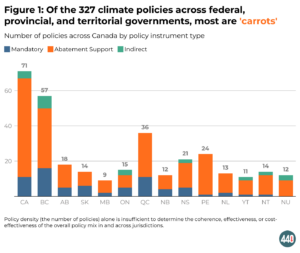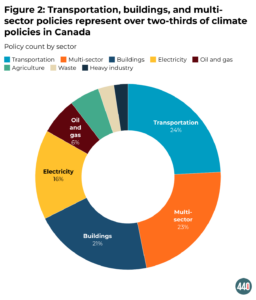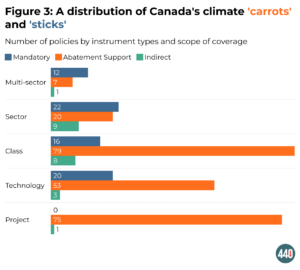The State of the Canadian Climate Policy Landscape

Originally posted by the Canadian Climate Institute: https://440megatonnes.ca/insight/state-canadian-climate-policy-landscape/
Introduction
Governments implement a variety of policies to reduce greenhouse gas emissions. This climate policy mix is increasingly complex and varies in instruments, design, coverage, and stringency.
To further complicate matters, tracking and assessing this complex mix of climate policies is particularly challenging in federations like Canada, where the responsibility for regulating emissions is shared between federal and provincial/territorial authorities, and municipal and Indigenous governments also have initiatives to reduce emissions.
In practice, this can mean poor coordination across orders of government and between policies. It can also lead to inefficiencies or unintended consequences that make achieving emissions reduction goals more difficult.
To help address these issues and provide researchers, policymakers, and businesses with a clear picture of ongoing efforts to reduce emissions, the Canadian Climate Policy Partnership (C2P2) has launched a comprehensive and dynamic database of climate policies in Canada: the Canadian Climate Policy Inventory. The inventory, with an interactive version hosted by the Canadian Climate Institute’s 440 Megatonnes initiative, allows for direct comparisons and a better understanding of the Canadian climate policy landscape.
In this insight, we open up the inventory to shine a light on the state of climate policy in Canada.
About the Inventory
The inventory compiles existing climate mitigation policies in Canada. It details the types of policies implemented by federal, provincial, and territorial governments using 20 different categories, including sectors, emissions sources targeted, and the types of instruments used. Our goal is to make this complex landscape of policies more transparent by offering a foundation for climate policy research and enabling governments to learn from each other and harmonize efforts.
The policies we include in the inventory are those whose primary purpose is to reduce greenhouse gas emissions. This excludes policies that may contribute to reducing emissions but are not implemented specifically for that objective—for example, gasoline excise taxes.
The inventory was initially populated using three major sources: Canada’s biennial reporting to the United Nations Framework Convention on Climate Change, a climate policy database housed on the 440 Megatonnes website developed by Navius Research Inc. and the Canadian Climate Institute, and earlier work by members of the project team on climate policy mixes in Canada. Between November 2022 and July 2024, the Institute regularly updated its climate policy database by reviewing the budgets and policy documents of federal, provincial, and territorial governments.
The inventory went through a rigorous review process, validated by more than 20 academics and federal, provincial, and territorial governments. As of its public launch in August 2024, it includes implemented, proposed, and announced policies across federal, provincial, and territorial jurisdictions through the end of April 2024. The inventory will be updated regularly to reflect new policy developments.
Insights from the Inventory
We identified 327 policies focused on reducing emissions across federal, provincial, and territorial jurisdictions (Figure 1). This inventory provides a broad picture of the climate policy landscape in Canada, allowing users to explore the different mitigation policy approaches across regions, sectors, and types of policies.
It’s important to emphasize that policy density (the number of policies) is not necessarily a good indicator of policy effort. For example, as the Canadian Climate Institute has shown, the effects of individual policies are not necessarily additive. Instead, metrics to account for stringency, coverage, and interactions are necessary to evaluate the effectiveness of policy action. This is future work C2P2 will undertake.
We categorize policies into three different instrument types, based on how they reduce emissions. Abatement support policies (policy “carrots” such as efficiency rebates for homeowners), which incentivize voluntary action, represent 71.5 per cent of the policy mix, vastly outnumbering mandatory policies requiring compliance (policy “sticks” like the federal fuel charge), which make up 22 per cent. Producer subsidies (such as the federal zero-emission vehicles tax write-off for businesses) represent 21.5 per cent of all policies, followed by consumer subsidies (such as provincial electric vehicle incentives (18 per cent)) and regulations (such as Alberta’s Methane Emission Reduction Regulation (15 per cent)). Indirect policies—those that allow for but don’t require or directly enable emissions reductions and thus have no direct mechanism to change behavior—such as enabling legislation (for example, British Columbia’s Energy Step Code for Buildings) and information policies (for example, Nunavut’s EnergyWise program) make up the smallest share (7 per cent).

Figure 1
The inventory also highlights the sectoral breakdown of mitigation policies in Canada. The transportation (24 per cent) and buildings (21 per cent) sectors dominate the mitigation policy landscape. Multi-sector policies (such as the federal fuel charge and output-based pricing system) are 23 per cent of the total policy count in the database (Figure 2).

Figure 2
Furthermore, policy instrument types also vary across scopes of application (Figure 3). As governments add policies to target emissions in different sectors to address gaps in the climate policy mix, these policies can range from broader to narrower applications. A multi-sector policy—such as the federal fuel charge—has broader application compared to the emissions reductions achieved by a narrowly applied, project-based policy.
Examples of project-based policies include the Inuvik Wind Farm (Northwest Territories) and the Climate Challenge Fund (Prince Edward Island). Policies designed for a specific type of technology include Newfoundland and Labrador’s electric vehicle incentive program. Class-based policies are those that apply to a class of technologies (for example, heat pumps) or emissions (for example, policy targeting methane emissions). Broad policies applied to one or more sectors are more likely to be mandatory. Abatement support policies are the majority of more narrowly targeted policies.

Figure 3
Policies will incentivize different levels of emissions reductions depending on their scope and stringency. Individual policies with multi-sector scope and mandatory design are likely to account for an outsized impact on emissions reduction. For example, analysis by the Canadian Climate Institute and Navius Research suggests that industrial carbon pricing systems are expected to account for 20–48 per cent of emissions reductions from the federal Emissions Reduction Plan moving forward.
It is not surprising that governments have focused more on abatement support policies (subsidies, or carrots) which are often more tailored to a specific technology, than on broader mandatory policies (regulations, or sticks), given the political challenges and lengthy processes associated with implementing broadly applied mandatory policies such as emissions pricing and regulations.
The Road Ahead
Canada’s climate policy landscape varies significantly across provinces and territories due to differences in economic structure, political ideologies, energy resources, and emissions. This complexity makes it challenging to understand policy interactions, overlaps, and gaps. The Canadian Climate Policy Inventory is a starting point for addressing this problem.
We also need to better understand policy stringency and coverage over time, both between and within jurisdictions. This database is the first step in the C2P2 research program to develop improved metrics for policy coverage and stringency across Canada, and to better understand policy interactions, overlaps, and gaps.
The climate policy landscape is constantly changing due to stricter regulations, evolving technologies, changes in government, and shifting geopolitical contexts. The C2P2 team will continually update the database to reflect new information.
About C2P2
The Canadian Climate Policy Inventory is a project of the Canadian Climate Policy Partnership (C2P2). The goal of C2P2 is to inform smart, coherent and new policy options to meet Canada’s net zero transition by engaging in data-driven research on and analysis of climate policies in Canada, and supporting such activities in a broader network of researchers. C2P2 is a research initiative led by Dr. Jennifer Winter at the University of Calgary. Partners and funders include the Canadian Climate Institute, CIRANO (Centre Interuniversitaire de Recherche en Analyse des Organisations), the Government of British Columbia, the Government of Canada, Mitacs, Quebec NetPositif, Royal Roads University, the Smart Prosperity Institute, the Social Sciences and Humanities Research Council, the Office of the Vice-President (Research) at the University of Calgary, and the School of Public Policy at the University of Calgary.
Jennifer Winter is a Professor in the Department of Economics and the School of Public Policy at the University of Calgary, and the Departmental Science Advisor at Environment and Climate Change Canada.
William Scott is an Assistant Professor at the Simon Fraser University School of Public Policy.
Alaz Munzur is an Assistant Professor of Economics at the Johnson Shoyama Graduate School of Public Policy, University of Saskatchewan.
Katharina Koch is a Research Associate at the School of Public Policy, University of Calgary.


